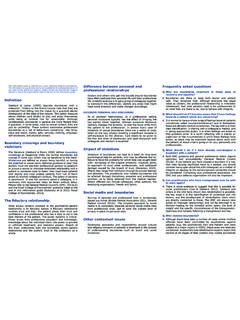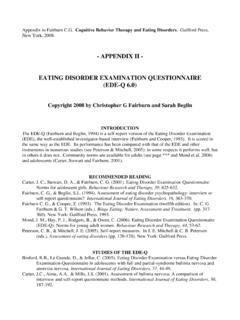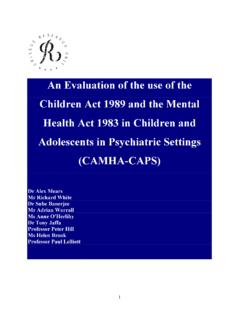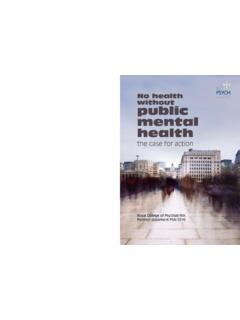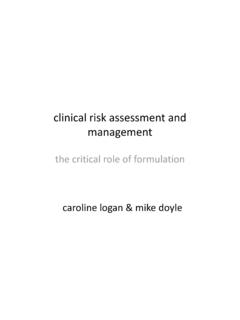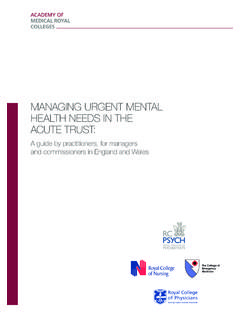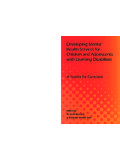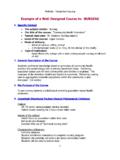Transcription of Drugs and Alcohol – Whose problem is it anyway? …
1 1 Drugs and Alcohol Whose problem is it anyway? Who cares? Summary Stigma and substance misuse are closely linked. This article looks at what can be done to understand how we can destigmatise substance misuse and comes to an intriguing conclusion: substance misuse behaviour is stigmatised correctly, whilst the substance misusing individual should have his/her stigma removed to reduce barriers to coming forward for increasingly effective treatment. Primary health care is ideally placed to offer screening for substance misuse and early intervention. Substance misuse in the workplace is costly in both human and financial terms. Work place testing offers an opportunity to detect such problems and provide appropriate help. However, it is not a panacea and results should be interpreted as part of a wider picture. The link between communicable diseases and substance misuse can result in an increase in stigma, even affecting national guidance on some treatments.
2 Treatments for drug and Alcohol problems are more available than ever and increasingly mainstreamed (eg in Primary Care). Self-help approaches are an established cornerstone and helplines offer accessible advice to the community at large. Health care education has a particular role in destigmatising substance misusers. The costs of substance misuse to the NHS are enormous, so it makes economic as well as clinical sense to invest in greater emphasis on addressing the issue, during both undergraduate and postgraduate training. Until this happens, health services will help to perpetuate stigma rather than take the lead in reducing it. Introduction Primary Health Care The work place and drug screening Communicable diseases Treatment Medical education Conclusion Introduction In many parts of society there is a high level of acceptance of Alcohol misuse, for instance in pubs, on Saturday night, leading to a high number of visits to Accident and Emergency Departments.
3 The problem has to go a long way before it is stigmatised Over the last twenty years drink/driving has become much more unacceptable, but a wide range of other drunken behaviour is still broadly accepted broadly and/or excused. It is important to be clear about who is being stigmatised and at what point in their drinking career Whilst Alcohol is our favourite drug , other Drugs are catching up. Mental health services used to be seen as Cinderella services, but drug and Alcohol services are her disadvantaged sibling the one you seldom hear about. Despite overwhelming evidence of biological, psychological and social factors contributing to substance misuse ( Drugs or Alcohol ), attitudes symbolise the triumph of the just - just stop! ; "just a matter of willpower/faith"; or just pull your socks up! . Overstretched services often demand motivation before anything is done; yet the main psychological treatment technique is designed for those with low or fluctuating impetus to receive help.
4 Until recently, most primary health care services could offer nothing but general help, feeling out of their depth in this area. Many places of work turned a blind eye or tacitly/inadvertently supported people in their substance misuse, despite the eventual damage to employer and employee alike. Historically, much of the response to substance misuse has surfed waves of public concern: communicable diseases since the 1980s and criminality since the 1990s. These supposed connections are not promising when it comes to destigmatisation. The next big issue might be the need to accept that many people with other mental health problems also misuse Drugs or Alcohol , and that this forms a complex cocktail of risk factors for them and for those around them. 2 There is a myth that health services aim to cure people. In that case, most clinics fail abjectly; yet no-one suggests that we should close services for people with diabetes or heart disease.
5 The negative view of substance misuse and the success of its treatment has led to under-investment services. It is surprising that mental health services in general, and substance misuse services in particular, have undervalued improving quality of life and reducing handicap. However, the emphasis is shifting for mental health and there are compelling arguments to offer treatment for people who misuse Drugs and Alcohol in order to improve their quality of life,. Minimising the damage caused by substance misuse is legitimate, and, done properly, will do no harm. Using alleviation of the problem as a criterion for success, there is good evidence that treatment works. Despite this encouraging finding, medical education (and that of other disciplines) lags behind. Like other common, serious issues (eg sleep disorders, sexual problems), substance misuse is all but ignored in most UK undergraduate medical curricula.
6 The ramifications of not addressing it touch patients, families, society at large and, not least, health services themselves. Primary Health Care UK health policy has placed primary care at centre stage. Increasingly, it shapes the rest of health care. The aphorism that an alcoholic is someone who drinks more than their doctor illustrates a socially tolerant attitude to Alcohol and denial that misuse can give rise to problems. There is an unwitting collusion between this view and the attitudes formed among the stereotypical rugby playing, heavy drinking, male medical student (albeit most current UK medical students are female). It is unsurprising that primary care is tolerant of Alcohol misuse. This reflects society s general failure to acknowledge problems associated with Alcohol and intolerant of " Drugs " again, reflecting popular perceptions and the populist line taken by some sectors of the media.
7 Many primary care teams think this way or adopt a more judgmental approach, more akin to that towards Drugs , where there has never been toleration of misuse amongst doctors. In fact, it is a common route to being struck off the medical register so that, where individual doctors have become dependent, it is a matter of shame and concealment. These attitudes form the backdrop both to the perception and to the reality of stigmatisation of Alcohol and drug misusers. Indeed, people who misuse substances often report such attitudes in their contacts with doctors and others working in primary care. Two groups believe themselves stigmatised. There are those who wish to continue their habit and resent not receiving prescriptions that will facilitate this. Then there are those who want help in ending their addiction but do not find it. Both groups believe that they do not achieve their ends because of wilful discrimination and stigmatisation.
8 Substance misusers are not alone in feeling that primary care does not always meet their needs. The various primary care organisations in the NHS, as well as individual practices, always have to make choices about the best use of scarce personal, financial and infrastructural resources. Substance misuse services are not considered to be a high priority and practices may refuse to provide them. The result is stigmatisation through discrimination, a fine distinction lost on those seeking help. It can result in individuals not being accepted on to practice lists, with a consequent inability to obtain other required care not directly related to substance misuse. People may feel stigmatised by the diagnostic terms used as professional shorthand on a provisional or definitive basis. The avoidance of labelling individuals with preconceptions requires the members of the primary care team to exercise skill and delicacy in the use of language when communicating advice.
9 Scarcity and under-resourcing of specialised services often mean that it impossible to find effective care outside the practice, so increasing feelings of stigmatisation. Surveys have shown that, despite their professional training, some doctors share the stigmatising attitudes of society at large and allow this to carry over into their professional work. Better training and familiarisation with what can be achieved will overcome these attitudes. In 2002, the NHS in England started a considerable investment in training and material resources for the provision of expert drug and Alcohol services in primary care. 3In time, this investment should lead to adjustment of attitudes, especially those reflecting the view that such problems are thoughtlessly self-inflicted and, as in the days of the Poor Law, not deserving of care. Society has very different attitudes to different types of risky behaviour for a range of very complex reasons.
10 Perhaps the strongest argument is the case for humane and appropriate treatment for substance There are already some practice teams that are able to take on a substantial workload in the field. This requires individual knowledge and enthusiasm, proper training and resources, control of numbers accepted, the use of care and treatment contracts with patients and specialised, secondary backup. Without these, it is easy for services to be overwhelmed by demand, to the detriment of the range of services that the practice must provide. An important source of stigma and discriminatory attitudes among primary care professionals is bad experiences with a minority of patients. The numbers resorting to violence are very small, and dwarfed by those who harm themselves, but they are often persistent and repeatedly take up much time, causing disproportionate damage to a practice s professional image and its ability to care properly for its other patients.


